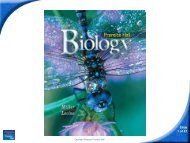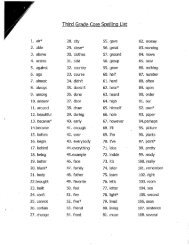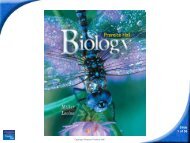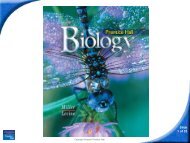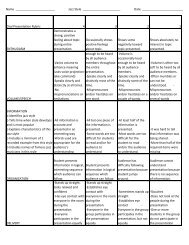Create successful ePaper yourself
Turn your PDF publications into a flip-book with our unique Google optimized e-Paper software.
Biology<br />
Slide<br />
1 of 28<br />
Copyright Pearson Prentice Hall
<strong>18</strong>-3 <strong>Kingdoms</strong> <strong>and</strong> <strong>Domains</strong><br />
Slide<br />
2 of 28<br />
Copyright Pearson Prentice Hall
<strong>18</strong>-3 <strong>Kingdoms</strong> <strong>and</strong> <strong>Domains</strong><br />
The Tree of Life Evolves<br />
(The Tree of Life Evolves<br />
Systems of classification adapt to new discoveries.<br />
Linnaeus classified organisms into two kingdoms—<br />
animals <strong>and</strong> plants.<br />
The only known differences among living things<br />
were the fundamental traits that separated animals<br />
from plants.)<br />
Slide<br />
3 of 28<br />
Copyright Pearson Prentice Hall
<strong>18</strong>-3 <strong>Kingdoms</strong> <strong>and</strong> <strong>Domains</strong><br />
The Tree of Life Evolves<br />
(Five <strong>Kingdoms</strong><br />
Scientists realized there were enough differences<br />
among organisms to make 5 kingdoms:<br />
• Monera<br />
• Protista<br />
• Fungi<br />
• Plantae<br />
• Animalia)<br />
Slide<br />
4 of 28<br />
Copyright Pearson Prentice Hall
<strong>18</strong>-3 <strong>Kingdoms</strong> <strong>and</strong> <strong>Domains</strong><br />
The Tree of Life Evolves<br />
( Six <strong>Kingdoms</strong><br />
1990’s biologists recognized that Monera were<br />
composed of two distinct groups: Eubacteria <strong>and</strong><br />
Archaebacteria.)<br />
Slide<br />
5 of 28<br />
Copyright Pearson Prentice Hall
<strong>18</strong>-3 <strong>Kingdoms</strong> <strong>and</strong> <strong>Domains</strong><br />
The Tree of Life Evolves<br />
What are the six kingdoms of life as they<br />
are now identified<br />
Slide<br />
6 of 28<br />
Copyright Pearson Prentice Hall
<strong>18</strong>-3 <strong>Kingdoms</strong> <strong>and</strong> <strong>Domains</strong><br />
The Tree of Life Evolves<br />
1. The six-kingdom system of classification<br />
includes:<br />
• Eubacteria<br />
• Archaebacteria<br />
• Protista<br />
• Fungi<br />
• Plantae<br />
• Animalia<br />
Slide<br />
7 of 28<br />
Copyright Pearson Prentice Hall
<strong>18</strong>-3 <strong>Kingdoms</strong> <strong>and</strong> <strong>Domains</strong><br />
The Tree of Life Evolves<br />
Introduced<br />
1700’s<br />
Changing Number of <strong>Kingdoms</strong><br />
Names of <strong>Kingdoms</strong><br />
Plantae<br />
Animalia<br />
Late <strong>18</strong>00’s<br />
Protista<br />
Plantae<br />
Animalia<br />
1950’s<br />
1990’s<br />
Eubacteria<br />
Monera Protista Fungi Plantae<br />
Archaebacteria<br />
Protista Fungi Plantae<br />
Animalia<br />
Animalia<br />
Slide<br />
8 of 28<br />
Copyright Pearson Prentice Hall
<strong>18</strong>-3 <strong>Kingdoms</strong> <strong>and</strong> <strong>Domains</strong><br />
The Three-Domain System<br />
2. The Three-Domain System<br />
a. In 2000’s, Molecular analyses have given rise<br />
to a new taxonomic category<br />
b. domain –<br />
*is a more inclusive category<br />
* larger than a kingdom.<br />
Slide<br />
9 of 28<br />
Copyright Pearson Prentice Hall
<strong>18</strong>-3 <strong>Kingdoms</strong> <strong>and</strong> <strong>Domains</strong><br />
The Three-Domain System<br />
What is the three-domain system of<br />
classification<br />
Slide<br />
10 of 28<br />
Copyright Pearson Prentice Hall
<strong>18</strong>-3 <strong>Kingdoms</strong> <strong>and</strong> <strong>Domains</strong><br />
The Three-Domain System<br />
3. The three domains are:<br />
a. Eukarya<br />
* composed of protists, fungi, plants,<br />
<strong>and</strong> animals.<br />
b. Bacteria<br />
*corresponds to kingdom Eubacteria<br />
c. Archaea<br />
* corresponds to kingdom<br />
Archaebacteria.<br />
Slide<br />
11 of 28<br />
Copyright Pearson Prentice Hall
<strong>18</strong>-3 <strong>Kingdoms</strong> <strong>and</strong> <strong>Domains</strong><br />
Domain Bacteria<br />
4. Domain Bacteria<br />
a. are unicellular prokaryotes.<br />
b. cells have thick, rigid cell walls that<br />
surround a cell membrane.<br />
c. cell walls contain peptidoglycan.<br />
(polymer of sugar <strong>and</strong> amino acids that<br />
surround cell membrane)<br />
d. ecologically diverse- free-living soil<br />
organisms to deadly parasites<br />
e. some carry out photosynthesis<br />
f. some need oxygen<br />
Slide<br />
12 of 28<br />
Copyright Pearson Prentice Hall
<strong>18</strong>-3 <strong>Kingdoms</strong> <strong>and</strong> <strong>Domains</strong><br />
Domain Bacteria<br />
The domain Bacteria<br />
corresponds to the<br />
kingdom<br />
Eubacteria.<br />
Slide<br />
13 of 28<br />
Copyright Pearson Prentice Hall
<strong>18</strong>-3 <strong>Kingdoms</strong> <strong>and</strong> <strong>Domains</strong><br />
Domain Archaea<br />
5. Domain Archaea<br />
a. are unicellular prokaryotes.<br />
b. live in extreme environments.<br />
c. cell walls lack peptidoglycan<br />
d. their cell membranes contain unusual<br />
lipids not found in any other organism.<br />
e. corresponds to Kindgom Archaebacteria<br />
Slide<br />
14 of 28<br />
Copyright Pearson Prentice Hall
<strong>18</strong>-3 <strong>Kingdoms</strong> <strong>and</strong> <strong>Domains</strong><br />
Domain Archaea<br />
The domain<br />
Archaea<br />
corresponds to<br />
the kingdom<br />
Archaebacteria.<br />
Slide<br />
15 of 28<br />
Copyright Pearson Prentice Hall
<strong>18</strong>-3 <strong>Kingdoms</strong> <strong>and</strong> <strong>Domains</strong><br />
7. Structure <strong>and</strong> Function Prokaryotes<br />
(Bacteria <strong>and</strong> Archaea)<br />
a. Small- 1 to 5 micrometers<br />
b. Rod (bacilli), spherical (cocci), <strong>and</strong> spiral<br />
(spirilla) shaped<br />
c. Need supply of chemical energy for food;<br />
store as sugar molecules<br />
d. Release energy during cellular respiration,<br />
fermentation, or both<br />
e. reproduce by binary fission (double in size,<br />
split into 2 identical cells)<br />
Slide<br />
16 of 28<br />
Copyright Pearson Prentice Hall
<strong>18</strong>-3 <strong>Kingdoms</strong> <strong>and</strong> <strong>Domains</strong><br />
f. endospore is produced in unfavorable<br />
conditions ( thick internal wall surrounds<br />
DNA <strong>and</strong> some cytoplasm)<br />
*remain dormant for months – years<br />
g. exchange genetic information by conjugation<br />
(hollow bridge forms between 2 bacteria<br />
<strong>and</strong> genetic material moves from 1 to<br />
another. Allows bacteria to survive in new<br />
environment or to become resistant to<br />
antibiotics)<br />
Slide<br />
17 of 28<br />
Copyright Pearson Prentice Hall
<strong>18</strong>-3 <strong>Kingdoms</strong> <strong>and</strong> <strong>Domains</strong><br />
8. Importance of Prokaryotes:<br />
a. Decomposers<br />
*replenish supply of raw materials<br />
*essential in sewage treatment plants <strong>and</strong><br />
water purification plants<br />
b. Producers<br />
*most abundant photosynthetic organism<br />
in world<br />
*Key in all food chains/webs<br />
c. Nitrogen fixers<br />
*Convert N 2 in useful forms<br />
d. Human uses<br />
*food <strong>and</strong> commercial products<br />
(Yogurt, drugs, digest petroleum)<br />
Copyright Pearson Prentice Hall<br />
Slide<br />
<strong>18</strong> of 28
<strong>18</strong>-3 <strong>Kingdoms</strong> <strong>and</strong> <strong>Domains</strong><br />
Domain Eukarya<br />
9. Domain Eukarya<br />
a. consists of organisms that have a nucleus.<br />
b. is organized into four kingdoms:<br />
1. Protista<br />
2. Fungi<br />
3. Plantae<br />
4. Animalia<br />
Slide<br />
19 of 28<br />
Copyright Pearson Prentice Hall
<strong>18</strong>-3 <strong>Kingdoms</strong> <strong>and</strong> <strong>Domains</strong><br />
Domain Eukarya<br />
Slide<br />
20 of 28<br />
Copyright Pearson Prentice Hall
<strong>18</strong>-3 <strong>Kingdoms</strong> <strong>and</strong> <strong>Domains</strong><br />
Domain Eukarya<br />
10. Protista<br />
(Its members display the greatest variety.)<br />
a. eukaryotic organisms<br />
b. unicellular or multicellular;<br />
c. photosynthetic or heterotrophic<br />
d. can share characteristics with plants,<br />
fungi, or animals.<br />
Slide<br />
21 of 28<br />
Copyright Pearson Prentice Hall
<strong>18</strong>-3 <strong>Kingdoms</strong> <strong>and</strong> <strong>Domains</strong><br />
Domain Eukarya<br />
11. Fungi<br />
a. heterotrophs.<br />
b. Most feed on dead or decaying organic<br />
matter (by secreting digestive enzymes<br />
into it <strong>and</strong> absorbing small food<br />
molecules into their bodies. )<br />
c. either multicellular (mushrooms) or<br />
unicellular (yeasts).<br />
Slide<br />
22 of 28<br />
Copyright Pearson Prentice Hall
<strong>18</strong>-3 <strong>Kingdoms</strong> <strong>and</strong> <strong>Domains</strong><br />
Domain Eukarya<br />
12. Plantae<br />
a. multicellular<br />
b. photosynthetic autotrophs.<br />
c. nonmotile—(they cannot move from place<br />
to place.)<br />
d. cell walls that contain cellulose.<br />
e. includes cone-bearing <strong>and</strong> flowering<br />
plants as well as mosses <strong>and</strong> ferns.<br />
Slide<br />
23 of 28<br />
Copyright Pearson Prentice Hall
<strong>18</strong>-3 <strong>Kingdoms</strong> <strong>and</strong> <strong>Domains</strong><br />
Domain Eukarya<br />
13. Animalia<br />
a. multicellular<br />
b. heterotrophic.<br />
c. do not have cell walls.<br />
e. Most can move about.<br />
(There is great diversity within the animal kingdom,<br />
<strong>and</strong> many species exist in nearly every part of the<br />
planet.)<br />
Slide<br />
24 of 28<br />
Copyright Pearson Prentice Hall
<strong>18</strong>-3<br />
Continue to:<br />
- or -<br />
Click to Launch:<br />
Slide<br />
25 of 28<br />
Copyright Pearson Prentice Hall
<strong>18</strong>-3<br />
Organisms whose cell walls contain<br />
peptidoglycan belong in the kingdom<br />
a. Fungi.<br />
b. Eubacteria.<br />
c. Plantae.<br />
d. Archaebacteria.<br />
Slide<br />
26 of 28<br />
Copyright Pearson Prentice Hall
<strong>18</strong>-3<br />
Multicellular organisms with no cell walls or<br />
chloroplasts are members of the kingdom<br />
a. Animalia.<br />
b. Protista.<br />
c. Plantae.<br />
d. Fungi.<br />
Slide<br />
27 of 28<br />
Copyright Pearson Prentice Hall
<strong>18</strong>-3<br />
Organisms that have cell walls containing<br />
cellulose are found in<br />
a. Eubacteria <strong>and</strong> Plantae.<br />
b. Fungi <strong>and</strong> Plantae.<br />
c. Plantae <strong>and</strong> Protista.<br />
d. Plantae only.<br />
Slide<br />
28 of 28<br />
Copyright Pearson Prentice Hall
<strong>18</strong>-3<br />
Molecular analyses have given rise to a new<br />
taxonomic classification that includes<br />
a. three domains.<br />
b. seven kingdoms.<br />
c. two domains.<br />
d. five kingdoms.<br />
Slide<br />
29 of 28<br />
Copyright Pearson Prentice Hall
<strong>18</strong>-3<br />
Which of the following contain more than one<br />
kingdom<br />
a. only Archaea<br />
b. only Bacteria<br />
c. only Eukarya<br />
d. both Eukarya <strong>and</strong> Archaea<br />
Slide<br />
30 of 28<br />
Copyright Pearson Prentice Hall
END OF SECTION





